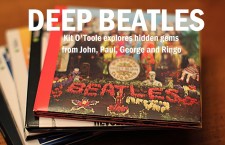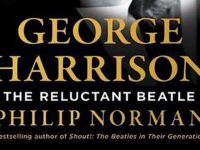The name “Mark Lewisohn” carries significant weight in the Beatles fan and scholar communities. During the 1980s and 1990s, the author published essential reference works for any Beatles enthusiast’s library. The Beatles Live!, The Beatles Recording Sessions, and The Complete Beatles Chronicle are still considered “bibles” for Beatles scholarship and crucial reading for any serious fan.
Lewisohn also won the endorsement of the surviving Beatles and their associates; they proved their allegiance by appointing him as a consultant on the Anthology documentary, albums, and book. In 2004, Lewisohn signed a contract to write a trilogy on the Beatles’ entire career. Almost ten years later the first installment, The Beatles, All These Years: Tune In, has finally arrived on bookshelves. One of the most hotly anticipated book releases for Beatles fans, the question remains: Does Tune In live up to such elevated expectations?
The answer depends on what the reader wishes to learn. Those looking for earth-shattering, jaw-dropping revelations may be disappointed, and fans who enjoy “digging the dirt” (Exhibit A: Peter Brown and Steven Gaines’ notorious 1983 bestseller The Love You Make) will find few truly tawdry details. However, Tune In covers a lesser-known period in the band’s history, from birth until 1962. Lewisohn leads readers on a journey through each Beatle’s family background, demonstrating how they came from modest beginnings. He paints a fond but rough picture of Liverpool, establishing its split personality: kind, fun, and warm one minute; brutal and unforgiving the next. Ringo Starr’s story is particularly evocative of this polarization: While his mother and stepfather seemed by all accounts doting and supportive parents, they could not escape the family cycle of poverty and addiction. “As many children have experienced down the years, the bond of good-time music and booze was significant,” Lewisohn writes. He cites Starr as recalling his family’s many booze-soaked parties thusly: “My parents were alcoholics and I didn’t realize it.”
Another important aspect of Tune In lies in its characterizations of George Harrison, John Lennon, Paul McCartney, and Starr. Previous works often gloss over their formative years, concentrating on their tawdry Hamburg adventures and triumphant return to Liverpool. No, Harrison did not pick up a guitar and magically begin to play, Lewisohn illustrates. Instead, he spent relentless hours learning songs note-for-note, carefully picking out each tune until he could play it flawlessly. A touching scene involving Harrison’s mother staying up late with him, encouraging him to keep practicing, shows how his parents supported him in his endeavors.
Seeing McCartney as a star-struck kid also amuses: Just like any other teenager, he worshipped his idols (Elvis Presley, Little Richard, and Buddy Holly) from afar. As if watching a play unfold, we experience McCartney seeing another icon — Bill Haley and his Comets — for the first time. “It happened exactly as Paul wanted it,” Lewisohn writes. “The lights went down, the house quivered expectantly, there was a dramatic pause in the darkness, Haley and his Comets began the call-and-response ‘On your marks, get set …’ opening to ‘Razzle Dazzle’ and then on the word ‘Go!’ the curtains flew open, the music started jumping, and the lights picked them out.” As the author weaves in McCartney’s later recollection of the event — “and there they were. … It was something special, and that’s what I was after: chills” — one can visualize a wide-eyed McCartney absorbing the power of rock ‘n’ roll.
Lewisohn spends time dissecting Lennon’s complex character, a challenging task for any researcher. He dispels some myths about Lennon’s upbringing (did a six-year-old John really have to choose whether to live with his mother or father?) and evokes a surprisingly sympathetic portrait of Lennon’s famously stern Aunt Mimi, the woman who raised him. His mother Julia receives a slightly harsher treatment here; Lewisohn details her free-spirited ways, numerous mistakes, and self-centered lifestyle. As in other works, Julia functions as Lennon’s sister or close friend rather than mother, which did Lennon no favors. The author makes no apology for Lennon despite these childhood setbacks. He frankly discusses the Beatle’s drinking and occasionally surly attitude, his obsession with physical deformities and his penchant for striking girlfriends. Lennon’s story is about context, Lewisohn seems to argue: He grew up in a male-dominated environment where macho postures kept one alive. (Just ask Starr, who briefly joined a gang in the Dingle, the Liverpool slum where he grew up. As Tune In makes clear, the decision was about survival.)
Obviously Lewisohn describes the day Lennon and McCartney first met at the St. Peter’s Church fete, and how Harrison later auditioned for the band by playing “Raunchy” perfectly. The Beatles’ original drummer Pete Best is painted as an aloof but harmless musician whom Lennon and McCartney recruited for convenience more than artistic drumming skills. Once Starr joined the group in 1962, the stars seemed in alignment: They recorded “Love Me Do,” and their careers officially began.
A Lewisohn quote is emblazoned on Tune In’s back cover: “Let’s scrub what we know, and start over. Who really were these people, and how did it all happen?” These two sentences effectively synthesize one of the book’s missions: to flesh these icons out as human beings, as four determined individuals who rose above difficult homes, poverty, and a pervading malaise to become agents of change in music and pop culture. Lewisohn thoroughly narrates their triumphs and failures, setbacks and accomplishments, and their complex private and public lives. He successfully argues that the Beatles were four regular guys, Liverpool lads who rose to the top through determination and a harsh work ethic. Through words, Lewisohn allows fans to experience the sights, sounds, and smells of Liverpool and Hamburg up to 1962. We can almost hear the skiffle music, see the foursome playing at family gatherings together and separately; and smell the beer and cigarette smoke as the Beatles played countless clubs.
Tune In vividly portrays the Beatles in their formative years, illustrating that their incredible success was no fluke. Perhaps anyone interesting in pursuing music as a career should read Lewisohn’s tome, as it shows that only through hard work and perseverance can one reach, as Lennon used to jokingly say, “the toppermost of the poppermost.”
[amazon_enhanced asin=”1400083052″ container=”” container_class=”” price=”All” background_color=”FFFFFF” link_color=”000000″ text_color=”0000FF” /] [amazon_enhanced asin=”1569765340″ container=”” container_class=”” price=”All” background_color=”FFFFFF” link_color=”000000″ text_color=”0000FF” /] [amazon_enhanced asin=”1454910054″ container=”” container_class=”” price=”All” background_color=”FFFFFF” link_color=”000000″ text_color=”0000FF” /] [amazon_enhanced asin=”1566567475″ container=”” container_class=”” price=”All” background_color=”FFFFFF” link_color=”000000″ text_color=”0000FF” /] [amazon_enhanced asin=”051757750X” container=”” container_class=”” price=”All” background_color=”FFFFFF” link_color=”000000″ text_color=”0000FF” /]
- How John Lennon Came Roaring Back on the Beatles’ White Album - November 22, 2023
- Five ‘With the Beatles’ Deep Cuts That Illustrate Their Lasting Debt to R&B - November 20, 2023
- Five Must-Hear Deep Cuts from the Beatles’ ‘Past Masters’ - March 7, 2023



